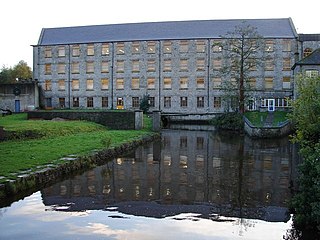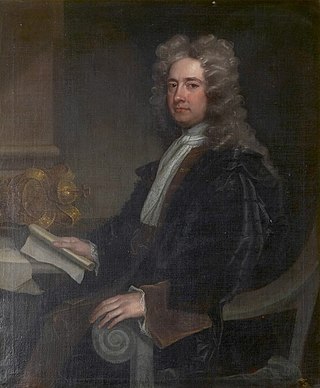
The title of Earl of Athlone has been created three times.

Esther Vanhomrigh or Van Homrigh, an Irish woman of Dutch descent, was a longtime lover and correspondent of Jonathan Swift. Swift's letters to her were published after her death. Her fictional name "Vanessa" was created by Swift by taking Van from her surname, Vanhomrigh, and adding Esse, the pet form of her first name, Esther.

The Treaty of Limerick, signed on 3 October 1691, ended the 1689 to 1691 Williamite War in Ireland, a conflict related to the 1688 to 1697 Nine Years' War. It consisted of two separate agreements, one with military terms of surrender, signed by commanders of a French expeditionary force and Irish Jacobites loyal to the exiled James II. Baron de Ginkell, leader of government forces in Ireland, signed on behalf of William III and his wife Mary II. It allowed Jacobite units to be transported to France, the diaspora known as the Flight of the Wild Geese.

Celbridge is a town and townland on the River Liffey in County Kildare, Ireland. It is 23 km (14 mi) west of Dublin. Both a local centre and a commuter town within the Greater Dublin Area, it is located at the intersection of the R403 and R405 regional roads. As of the 2022 census, Celbridge was the third largest town in County Kildare by population, with 20,601 residents.

The Battle of Aughrim was the decisive battle of the Williamite War in Ireland. It was fought between the largely Irish Jacobite army loyal to James II and the forces of William III on 12 July 1691, near the village of Aughrim, County Galway.

Godard van Reede, 1st Earl of Athlone was a Dutch States Army officer and nobleman who rose to prominence during the Williamite War in Ireland.

William Conolly, also known as Speaker Conolly, was an Irish Whig politician, Commissioner of Revenue, lawyer and landowner. He was an influential figure in Irish politics, serving as Speaker of the Irish House of Commons between 1715 and his death.

Claud Hamilton, 4th Earl of Abercorn PC (Ire) (1659–1691) was a Scottish and Irish peer who fought for the Jacobites in the Williamite War. He went with King James to Derry in 1689 and tried to negotiate the surrender of the town with Adam Murray. He raised a regiment of horse that he led in the defeats of Newtownbutler in 1689 and Aughrim in 1691. He was killed when the ship that should have brought him to France was intercepted by a Dutch privateer.
Events from the year 1697 in Ireland.

Celbridge Abbey is located in Celbridge, County Kildare in Ireland.

Barberstown Castle is a structure originally built in 1288 in Straffan, County Kildare, Ireland, 25 km west of Dublin. It has been operating as a hotel since 1971 and is surrounded by 20 acres (8.1 ha) of gardens. Renovations in 1996 revealed a previously undiscovered tunnel that links the castle to the nearby church in Straffan and is thought to have been used under the Penal Laws.

Gustavus Hamilton, 1st Viscount BoynePC (Ire) (1642–1723) was an Irish soldier and politician. In his youth, he fought in his cousin Sir George Hamilton's regiment for the French in the Franco-Dutch War. About 1678 he obtained a commission in the Irish Army. James II appointed him to the Irish Privy Council in 1685.

Colonel Thomas de Burgh, always named in his lifetime as Thomas Burgh, was an Anglo-Irish military engineer, architect, and Member of the Parliament of Ireland who served as Surveyor General of Ireland (1700–1730) and designed a number of the large public buildings of Dublin including the old Custom House (1704–6), Trinity College Library (1712–33), Dr Steevens' Hospital (1719), the Linen Hall (1722), and the Royal Barracks.
Thomas Marlay was an Irish politician and judge, who ended his career as Lord Chief Justice of Ireland. He is remembered chiefly for beginning the rebuilding of Celbridge Abbey, and as the grandfather of the statesman Henry Grattan.

Richard Marlay was Dean of Ferns from 1769 to 1787; and Bishop of Clonfert and Kilmacduagh from 1787 to 1795 when he was translated to Waterford and Lismore. He died in office on 1 July 1802.
Robert Marshall (c.1695–1774) was an Irish judge. He is remembered chiefly as co-executor and legatee of Esther Vanhomrigh, the beloved "Vanessa" of Jonathan Swift, although he was not a close friend of hers; indeed it is possible that they never met.
Thomas Marlay (1719–1784) was an Irish soldier of the eighteenth century.
William Dongan, 1st Earl of Limerick was an Irish Jacobite soldier and peer.
Robert Lindsay (1679-1743) was an Irish barrister, politician and judge in eighteenth-century Ireland. He is best remembered for his close friendship with Jonathan Swift, whom he advised on the legal aspects of the Drapier Letters.

Thomas Christmas was an Irish politician.















